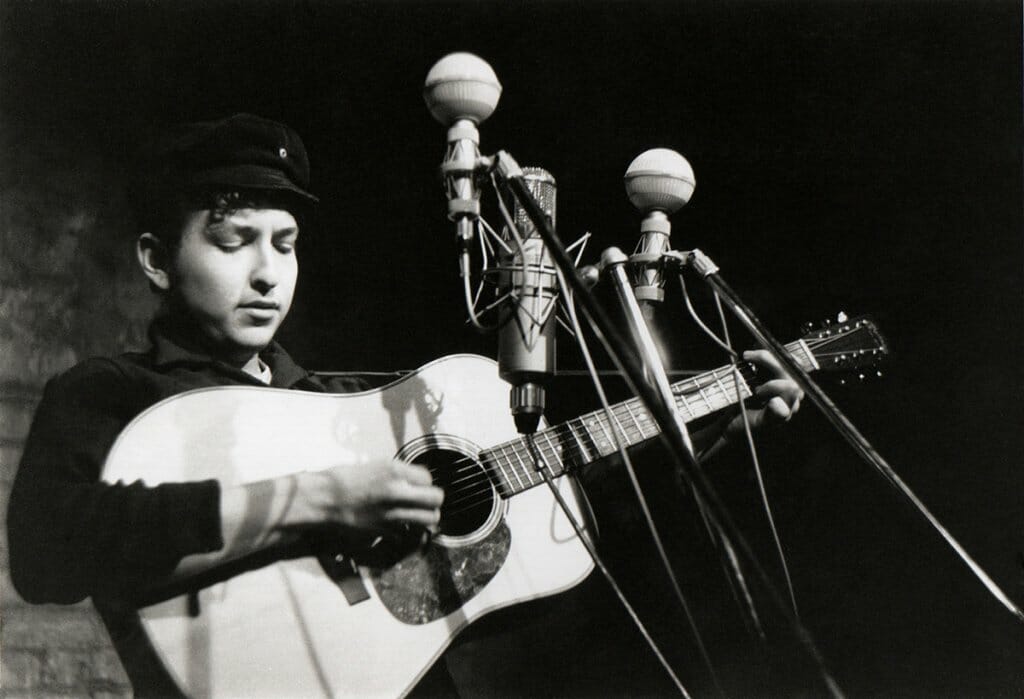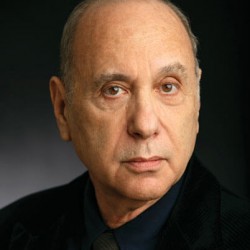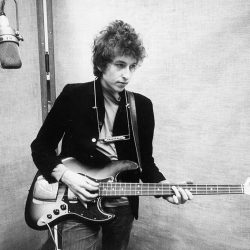Bob Dylan Flops on Campus
At 19, the future star failed to conquer the UW folk scene.

In 1961, Dylan’s future looked grim — until fate intervened at the end of his Madison stay. Sigmund Goode / Michael Ochs Archive / Getty Images
The extravagant Bob Dylan Center in Tulsa, Oklahoma, opened in May, completing Dylan’s apotheosis. Though perhaps completing is the wrong word, since the 81-year-old musician shows no signs of slowing down. After selling 125 million albums and winning Pulitzer and Nobel prizes, he’s still touring and writing singular songs. He even has a new book coming out this fall, The Philosophy of Modern Song.
Dylan is up there with the greatest American artists, but would you believe that his path to immortality passed through a few low-rent UW–Madison apartments?
In January 1961, the 19-year-old University of Minnesota dropout headed to Madison with his acoustic guitar and harmonica, hoping to conquer the campus folk scene. He managed to meet the top UW folkies but, alas, not to impress them. At that point, only the former Robert Zimmerman saw himself as a musical genius. He performed for students at Groves Women’s Co-op, wailed Woody Guthrie songs at campus parties, and turned precisely zero heads. What most people noticed was the kid’s oddball outfit: a brown suit and a skinny tie.
How did it feel to be in Madison as a complete unknown, with no direction home? “I’ve been broke and cold,” he wrote to friends back in Minneapolis. The future looked grim.
Dylan crashed with his new UW friends for about a week and a half — and then fate intervened. One of his roomies offered a ride to New York City, which was folk music’s mecca. The determined teenager arrived in Greenwich Village and began the artistic transformation that would soon lead to “Blowin’ in the Wind,” “A Hard Rain’s a-Gonna Fall,” and superstardom. When he traveled to Madison again in May 1961, staying with friends for another couple weeks, his guitar and vocals rang with new authority.
Dylan has returned to town many times since his two campus-area stays, treating generations of UW students to his various incarnations: fierce protest singer, gnomic rocker, poetic country crooner, true-believing gospel shouter, raspy jazz traditionalist. His latest Madison appearance was in 2012, at the 10,000-seat Alliant Energy Center. Were any 1961-era alumni in attendance that night, when he played a decades-spanning set of masterpieces such as “All Along the Watchtower,” “Like a Rolling Stone,” and “Tangled Up in Blue”?
If so, they surely marveled at how many roads this man has walked down since flopping at Groves Women’s Co-op.
Published in the Fall 2022 issue



Comments
Ron Radosh September 2, 2022
I was the first person Bobby called when he got to Madison by bus, and I spent time with him during his first visit and his return in the Spring. I also recorded a long filmed interview about my time with Bob in Madison for the Bob Dylan Archives and the Dylan Museum and Library in Tulsa, OK.
I was quite offended at the ridiculous headline- “Bob Dylan Flops on Campus”- and Mr. Robbins’ claim that he did not “impress” the folk crowd and “turned precisely zero heads.” Mr. Robbins might have called those of us who were Bob’s friends in Madison before writing the article. The group includes writer, musician and playwright Marshall Brickman, the prize-winning poet Ann Lauterbach, the banjo picker Paul Prestopino, the great blues player Danny Kalb, and the future CEO of Publisher’s Weekly, Freddy Ciporen.
I and others would tell you that from the start, we recognized his charisma, his craft and his singing. Aside from playing at The Pad on State Street various times, and in Groves’ Co-op, Bob often sat on the grass (before it was paved) in the back of the Student Union, where he would take out his guitar and give impromptu performances for small groups of students- anywhere from 10 to 20. There were few of us in the folk scene who could manage that.True, as Bob himself has written, he was a “Woody Guthrie songbook,” but he also played scores of traditional folk songs and ballads, beautifully excelling in his renditions.
The Museum has one exhibit in which listeners to that section can hear him sing one of these ballads taken from “the Madison tapes,” tape recordings made by another Madison friend that are now held by the Dylan Library and Dylan’s management in New York. Hopefully at some time in the future Columbia will release them as a bootleg, and everyone can hear what Bob sounded like then.
Ron Radosh, B.A. ’55; Ph.D., 1967
irvin peckham December 29, 2024
You also have something else wrong. Dylan came played at UW Madison in 1967. My roommate, Pat Quinn, got me to go with him to see Dylan at the play theater. About 100 people were there. He was good; not particularly outstanding, but very good.
irvin peckham December 29, 2024
might have been 66